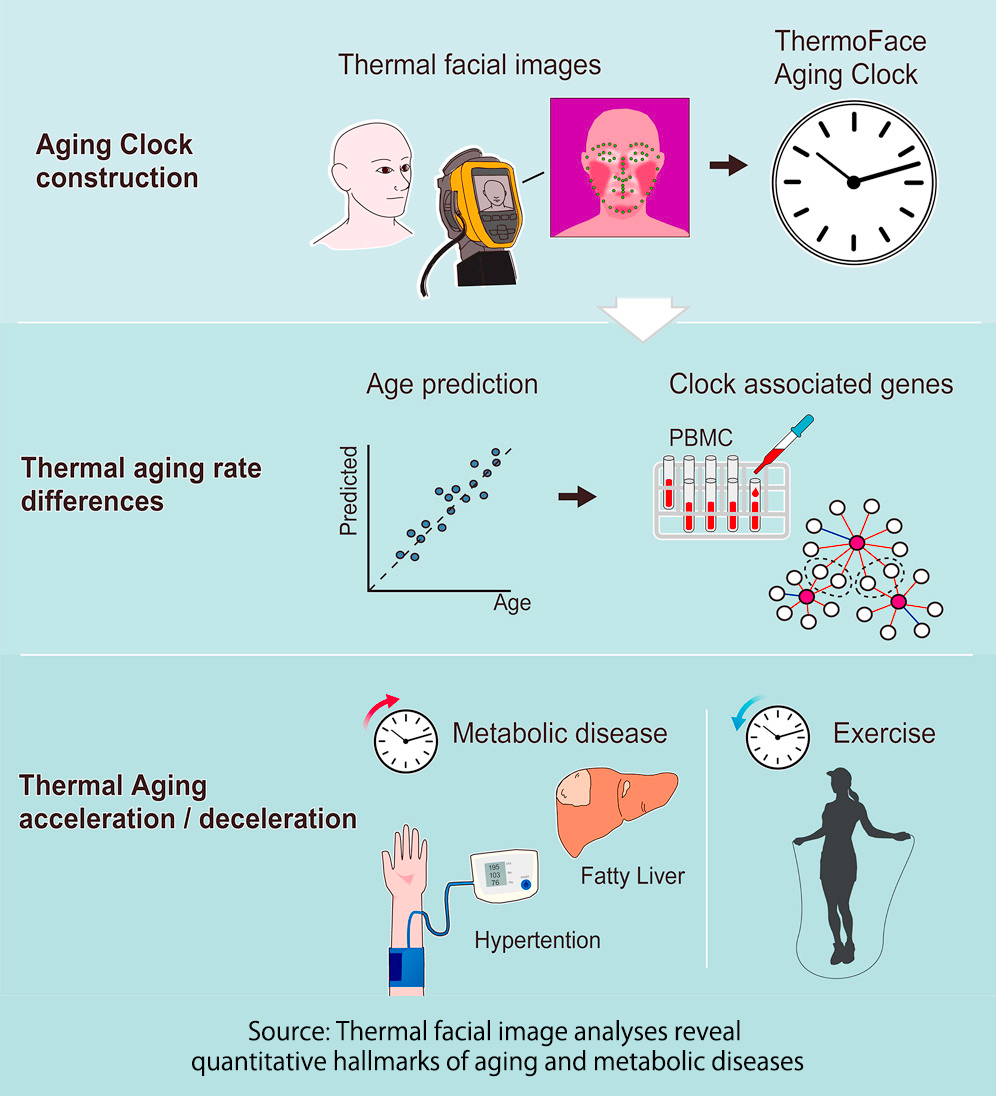
Anyone who has uttered, “They look younger (or older) than their age,” knows that our age on the calendar may vary quite a bit from our biological age. Many biological clocks are designed to indicate our biological age, but all are hampered by the fact that our definition of aging is unclear. A new entry for a biological clock builds from the generalization that our metabolism generates our body temperature and that as we age, our metabolism slows, lowering our body temperature. Spoiler alert: metabolism is the key to what is being measured.
Caloric restriction slows our metabolism, decreases our body temperature, and increases lifespan, at least in our rodent friends. Body temperature is also somewhat labile, like metabolic rate. It can be increased under psychological and metabolic stress – patients with diabetes have impaired thermoregulation. However, this is due to both metabolic stress and alterations in the blood vessels involved in dissipating heat.
The human face contains a wealth of information
The study is reported from China, where there is an ongoing attempt to merge traditional Chinese Medicine (TCM) with Western Medicine and science. Inspection of the tongue and face are important components in TCM diagnostics, and the rise in the ability to perform detailed facial scans coupled with machine learning offered researchers a means to quantify TCM.
“Precise quantification of temperature distribution features of the human face with aging and various diseases has not been explored, and it is still a mystery whether facial thermographic sub-regional features can be used as a marker of aging or diseases, as advocated by traditional Chinese medicine.”
To develop their clock, researchers collected 2800 thermal facial images combining infra-red and visible images in individuals aged 21 to 88 and of both sexes. The maps based on features of both the visible and thermal images were standardized into a facial map consisting of about 900 triangles. The researchers found the overall patterns were “relatively stable individual-wise and might be regarded as individual signatures.”

- With aging, thermal patterns in specific facial clusters change, beginning about a decade earlier for females.
- The lower nasolabial folds and lower cheeks show a linear age-dependent increase in temperature
- The nose and nasal-mouth region show an abrupt, age-dependent temperature drop starting at 50 years old. The forehead, eyes, and upper nasal labial folds show an opposite pattern
- The eye corners show the lowest temperature in middle age.
The researchers applied statistical and machine learning algorithms to the data, creating three similar “clocks.” As you might surmise, an individual's underlying metabolic state was more reflected in the thermal images, and lifestyle (I’m speaking to those of you tanning or smoking) more reflected in visual images. Sleep, unsurprisingly, also seemed to reset the thermal clock back in time. On the other hand, exercise and yogurt consumption set the thermal and visual clocks back. The mechanism for the action of yogurt consumption is unclear.
 Metabolic pathways associated with energy consumption, such as fighting a viral infection, speed up the thermal clock. In contrast, pathways related to energy release tended to set the clock back. Diabetes advanced the thermal clock by more than 6 years, although it advanced the facial clock by just under 3 years, implying that it is a better reflection of underlying health.
Metabolic pathways associated with energy consumption, such as fighting a viral infection, speed up the thermal clock. In contrast, pathways related to energy release tended to set the clock back. Diabetes advanced the thermal clock by more than 6 years, although it advanced the facial clock by just under 3 years, implying that it is a better reflection of underlying health.
While the research establishes that the fusion of machine learning and facial imaging can measure biological aging, it is unclear what diagnostic role thermal facial images might play. Metabolic rate is an aggregate of the individual metabolism at both the organ and cellular level, making it a more general than specific diagnostic finding. Moreover, compared to other biochemical or genetically based clocks, the thermal clock is more labile and is influenced by ambient temperature, seasonal influences, and even a participant’s emotional state.
Metabolism plays a crucial role in the aging process, offering valuable insights into biological aging, aligning with traditional Chinese medicine's emphasis on the face and body as mirrors of internal health. While the diagnostic use of thermal facial images is uncertain, the research demonstrates how integrating TCM principles with contemporary science may provide a more holistic approach to health and aging.
Source: Thermal facial image analyses reveal quantitative hallmarks of aging and metabolic diseases Cell Metabolism DOI: 10.1016/j.cmet.2024.05.012



